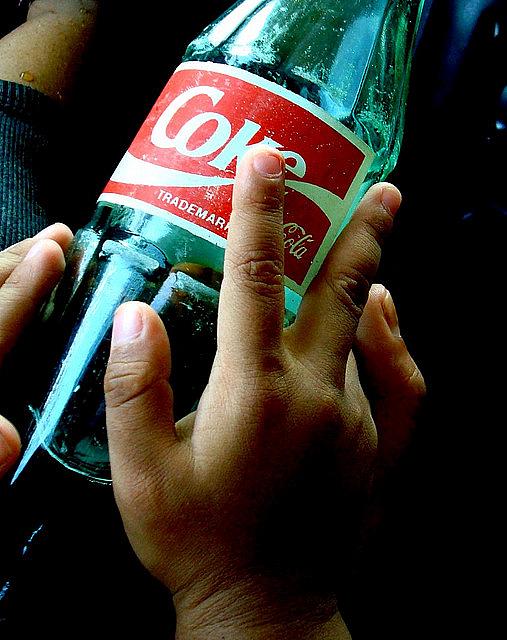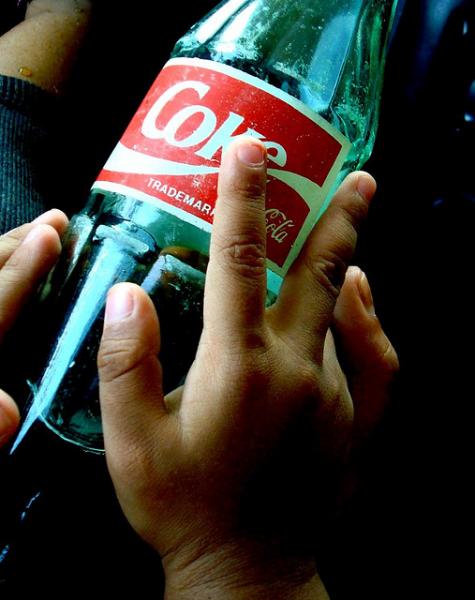Big Gulps for Little Leagues: Connecting Youth Sports And Obesity

 Coca-Cola says it does not market its soft drinks "in venues where children under the age of 12 are the primary audience."
Coca-Cola says it does not market its soft drinks "in venues where children under the age of 12 are the primary audience."
This is what a Coca-Cola executive told a Chicago Tribune reporter last week. The company itself goes even further. On its website, it says:
We have a global Responsible Marketing Policy that covers all our beverages, and we do not market any products directly to children under 12. This means we will not buy advertising directly targeted at audiences that are more than 35% children under 12. Our policy applies to television, radio, and print, and, where data is available, to the Internet and mobile phones.
Go to your nearest youth sports facility and see how long it takes you to spot a Coca-Cola logo. In a few minutes online, I found the following:
Young kids playing soccer in Coca-Cola jerseys and being given Coca-Cola branded prizes in Singapore.
Elementary school students gathered around a Coca-Cola truck to learn about recycling in Illinois.
Kids proudly displaying a giant check from Coca-Cola in New Jersey.
Coca-Cola launching a national, branded Support My School campaign in India.
Third graders being taught about Coca-Cola in Massachusetts.
Coca-Cola sub-brand Sprite launching a Refresh Your Playground Sweepstakes for K-12 schools.
I really could do this all day. I collected these and other examples on Tumblr and would love to add any of your favorites, too.
What would be even more productive would be for some reporters at local news outlets to take a hard look at the types of agreements that soft drink distributors make with local parks departments, schools and other agencies. I wrote about one of these arrangements last week that made Coca-Cola products the exclusive drink for events at parks in St. Paul, Minnesota. I found similar agreements – again, in a matter of minutes – in Troup County in Georgia, Oklahoma City, and Pembroke Pines in Florida.
These types of agreements are not unusual – nor scandalous. But they do deserve scrutiny in the context of childhood obesity. The U.S. Centers for Disease Control and Prevention reports that the "percentage of children aged 6–11 years in the United States who were obese increased from 7% in 1980 to nearly 20% in 2008." That means 1 out of every 5 kids is considered obese, a stunning fact and a potentially serious public health threat.
Beth Feinstein-Bartl at the Florida Sun-Sentinel wrote about a deal that Pembroke Pines made with Coca-Cola Enterprises, which is one of Coca-Cola's largest bottlers and distributors. As she wrote, for parks departments, these deals are all about money:
Dean Combs, the city's parks and recreation director, said he is pleased with the increased funds. "By agreeing to be a Coca-Cola city, we're able to package together this deal and create additional revenue," he said. All money from Coca-Cola Enterprises goes into the city's general fund. In addition to the $12,500 exclusive vending rights fee paid annually under the old contract, the city earned $22,661 from gross revenue sales of Coca-Cola products in 2001 and $24,857 in 2002, Combs said. Over the span of the agreement, Coca-Cola Enterprises has given 14 scoreboards, several outdoor tables with umbrellas, drinking coolers, sports drink mixes, towels, clipboards, squeeze bottles and other promotional items to the Parks and Recreation Department, he said.
"Everything has the company's logo," Combs said. "The items that benefit them also benefit us because we don't have to go out and buy it for our sports teams."
What does obesity cost Pembroke Pines in terms of shortened life spans, decreased productivity and strains on the health system? I'm not sure, but I bet it's more than $24,857 a year.
There's a larger discussion to be had about how much Coca-Cola and other food companies can actually be blamed for the high rates of obesity in the United States and elsewhere, but this story can have a nice, tight focus. It starts with a clear question: Are schools, sports programs and parks being used as vehicles to market high-sugar and high-fat products to kids?
Get a hold of some of these agreements that distributors have with park departments, schools, and youth sports leagues. See how they allow for marketing to kids on paper. Then see what's actually happening on the ground. Find out if these deals are in conflict with corporate policies by Coca-Cola and other companies. Is Coca-Cola, for example, telling the world that it does not market to kids but then letting its distributors slap Coke logos on every tiny jersey on the planet?
The photos of kids in Coca-Cola jerseys and running tracks lined with Coca-Cola banners start to tell that story. Your reporting will tell the rest.
Send your snapshots and your ideas to askantidote@gmail.com or via Twitter @wheisel.
Related Posts:
Photo credit: rhinoji via Flickr

